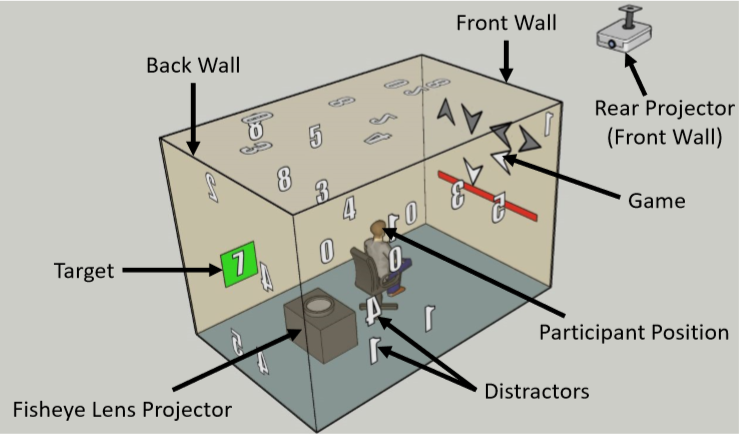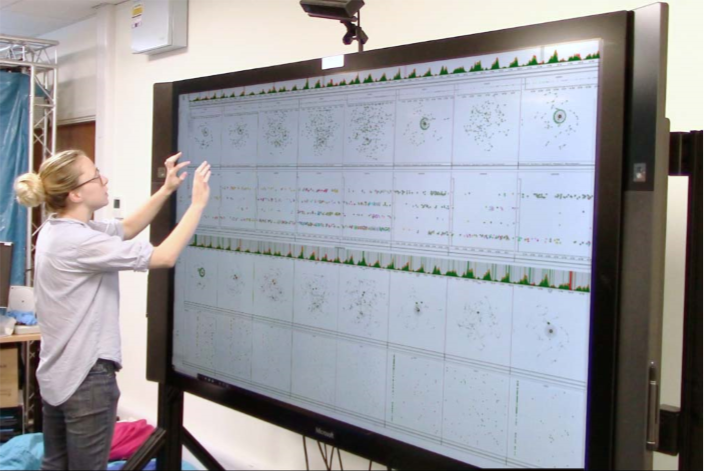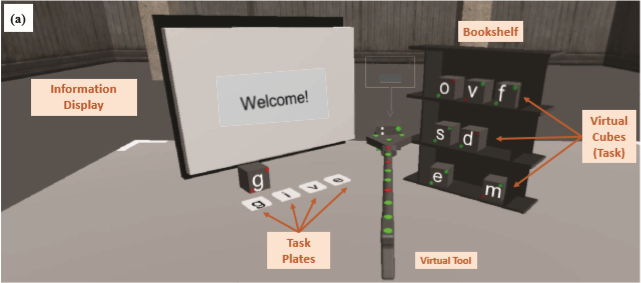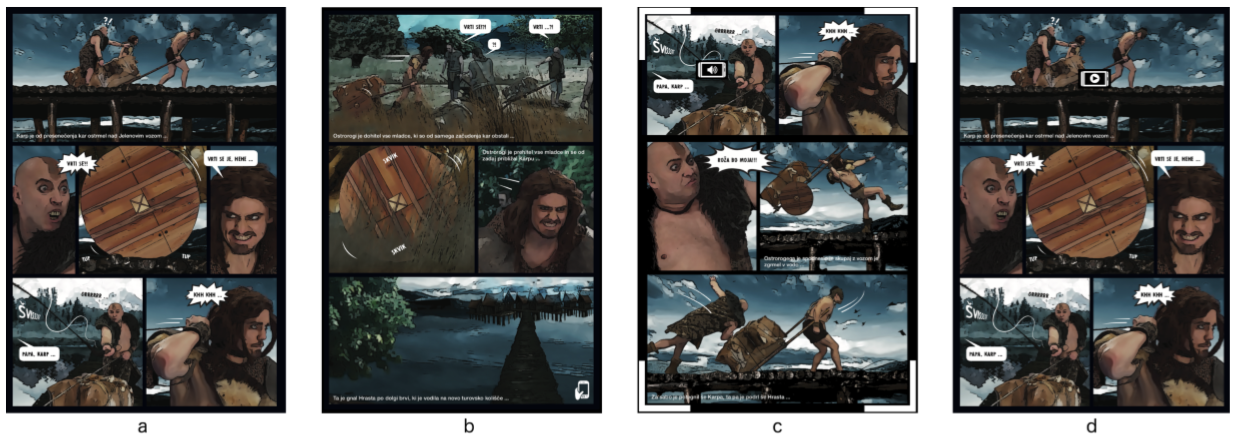 As CHI 2019 is held just around the corner in Glasgow, SACHI will be in full force at the conference, and keen to engage and speak about collaborations and research visits at St Andrews.
As CHI 2019 is held just around the corner in Glasgow, SACHI will be in full force at the conference, and keen to engage and speak about collaborations and research visits at St Andrews.
Alongside 5 full papers, 2 workshop presentations and 4 student volunteers, we’ve also put together a SICSA poster that we will be giving away at CHI that represents and summarises HCI research in Scottish Universities!
Come and find us to claim yours!

Full Papers
RotoSwype: Word-Gesture Typing using a Ring
Aakar Gupta, Cheng Ji, Hui-Shyong Yeo, Aaron Quigley & Daniel Vogel
DOI: 10.1145/3290605.3300244
We propose RotoSwype, a technique for word-gesture typing using the orientation of a ring worn on the index finger. RotoSwype enables one-handed text-input without encumbering the hand with a device, a desirable quality in many scenarios, including virtual or augmented reality. The method is evaluated using two arm positions: with the hand raised up with the palm parallel to the ground; and with the hand resting at the side with the palm facing the body. A five-day study finds both hand positions achieved speeds of at least 14 words-per-minute (WPM) with uncorrected error rates near 1%, outperforming previous comparable techniques.

A comparison of guiding techniques for out-of-view objects in full-coverage displays
Petford, J., Carson, I., Nacenta, M., & Gutwin, C..
DOI: 10.1145/3290605.3300288
Full-coverage displays can place visual content anywhere on the interior surfaces of a room (e.g., a weather display near the coat stand). In these settings, digital artefacts can be located behind the user and out of their field of view – meaning that it can be difficult to notify the user when these artefacts need attention. Although much research has been carried out on notification, little is known about how best to direct people to the necessary location in room environments. We designed five diverse attention-guiding techniques for full-coverage display rooms, and evaluated them in a study where participants completed search tasks guided by the different techniques. Our study provides new results about notification in full-coverage displays: we showed benefits of persistent visualisations that could be followed all the way to the target and that indicate distance-to-target. Our findings provide useful information for improving the usability of interactive full-coverage environments.

Dynamic Network Plaid: A Tool for the Analysis of Dynamic Networks
Alexandra Lee, Daniel Archambault, Miguel Nacenta
DOI: 10.1145/3290605.3300360
Network data that changes over time can be very useful for studying a wide range of important phenomena, from how social network connections change to epidemiology. However, it is challenging to analyze, especially if it has many actors, connections or if the covered timespan is large with rapidly changing links (e.g., months of changes with changes at second resolution). In these analyses one would often like to compare many periods of time to others, without having to look at the full timeline. To support this kind of analysis we designed and implemented a technique and system to visualize this dynamic data. The Dynamic Network Plaid (DNP) is designed for large displays and based on user-generated interactive timeslicing on the dynamic graph attributes and on linked provenance-preserving representations. We present the technique, interface and the design/evaluation with a group of public health researchers investigating non-suicidal self-harm picture sharing in Instagram.

Quantitative measurement of tool embodiment for virtual reality input alternatives
Alzayat, A., Hancock, M., Miguel Nacenta
DOI: 10.1145/3290605.3300673
Virtual reality (VR) strives to replicate the sensation of the physical environment by mimicking people’s perceptions and experience of being elsewhere. These experiences are of-ten mediated by the objects and tools we interact with in the virtual world (e.g., a controller). Evidence from psychology posits that when using the tool proficiently, it becomes em-bodied (i.e., an extension of one’s body). There is little work,however, on how to measure this phenomenon in VR, andon how different types of tools and controllers can affect the experience of interaction. In this work, we leverage cognitive psychology and philosophy literature to construct the Locus-of-Attention Index (LAI), a measure of tool embodiment. We designed and conducted a study that measures readiness-to-hand and unreadiness-to-hand for three VR interaction techniques: hands, a physical tool, and a VR controller. The study shows that LAI can measure differences in embodiment with working and broken tools and that using the hand directly results in more embodiment than using controllers.

Augmentation not Duplication: Considerations for the Design of Digitally-Augmented Comic Books
Matjaž Kljun, Klen Čopič Pucihar, Jason Alexander, Maheshya Weerasinghe, Cuauhtli Campos, Julie Ducasse, Barbara Kopacin, Jens Grubert, Paul Coulton, Miha Čelar
DOI: 10.1145/3290605.3300333
Digital-augmentation of print-media can provide contextually relevant audio, visual, or haptic content to supplement the static text and images. The design of such augmentation–its medium, quantity, frequency, content, and access technique–can have a significant impact on the reading experience. In the worst case, such as where children are learning to read, the print medium can become a proxy for accessing digital content only, and the textual content is avoided. In this work, we examine how augmented content can change the reader’s behaviour with a comic book. We first report on the usage of a commercially available augmented comic for children, providing evidence that a third of all readers converted to simply viewing the digital media when printed content is duplicated. Second, we explore the design space for digital content augmentation in print media. Third, we report a user study with 136 children that examined the impact of both content length and presentation in a digitally-augmented comic book. From this, we report a series of design guidelines to assist designers and editors in the development of digitally-augmented print media.

Workshop Position Papers
HCI for Accurate, Impartial and Transparent Journalism: Challenges and Solutions
Deb8: collaborative fact checking
Guilherme Carneiro
The rise of fake news, often from politicians and source generators, is a common problem in journalism. It affects not only mainstream media but also draws into question the trustworthiness of much information seen online. To improve the accuracy and impartiality of journalism we introduce Deb8, a collaborative tool for fact checking in videos which can enhance the transparency of news production while engaging the public in constructive social discourse around topics under active debate.
Workshop on Immersive Analytics: Interaction Design and Prototyping for Immersive Analytics
Walkers—Encoding Multivariate Data into Human Motion Sequences
Iain Carson, Uta Hinrichs, Aaron Quigley
The human perceptual system is highly efficient and effective at processing visual information, even at a pre-conscious level. Data visualisation leverages these functions to extract meaning and patterns from data, reducing cognitive load. Yet, the design of visualisations that represent multivariate data is still a challenge — as the number of data attributes increases, so does the complexity of visualisations, with it, the complexity of analysis processes potential users are facing. Many algorithms exist that support dimension reduction, leading to simpler, yet less nuanced visualisations in 2D space. We propose a novel way of presenting complex multivariate data using dimensional reduction that leverages humans’ ability to quickly process and decipher even complex sequences and compositions of motions to extract social cues.
By encoding data into biomechanical motion of abstract figurines —walkers— and then using Point Light Displays to convey their motion in isolation, our proposed technique for data visualisation results in subconscious dimensional reduction and pattern recognition, enabling a meaningful overview of complex multivariate data with little cognitive effort. In this workshop paper, we introduce walkers as a novel visualisation concept and describe how this idea could be integrated into potential immersive analytics application scenarios. We also discuss the research questions that the idea of encoding data into biomechanical motion raises in the context of immersive analytics.
Other Activities
-
- Miguel will be attending/helping with the SIGCHI meeting for the Future of SIGCHI Conferences.
- Miguel will help at the SICSA stand during the CHI’19 Newcomers reception (on Sunday)
Student Volunteers
SACHI student volunteers this year are:
- Pireh Pirzada
- Xu Zhu
- Janis Wong
- Yaxiong Lei
If you see them, be sure to say hi!
Event details
- When: 5th May 2019 - 9th May 2019

